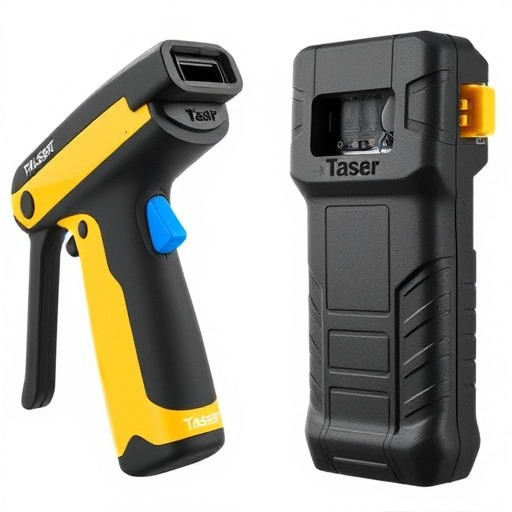Stun guns and tasers are non-lethal weapons for self-defense. Stun guns use a single probe to deliver a powerful electric shock, temporarily disabling opponents through localized nerve disruption. Tasers, in contrast, employ two thin probes that fire from a distance, causing muscle spasms by interrupting nerve signals. While both subdue without permanent harm, stun guns are safer for close encounters due to their localized effects, while tasers have a longer range and can control multiple targets simultaneously.
Exploring the difference between stun guns and tasers is crucial for understanding their unique applications in self-defense and law enforcement. This article demystifies these devices by explaining how they work, their legal status, safety considerations, and real-world effectiveness. We’ll break down power output, range, user safety, cost, and more to help you navigate the choices between these conductive energy devices.
Understanding Stun Guns and Tasers: Basic Definitions
Stun guns and tasers are both non-lethal weapons designed to incapacitate an opponent temporarily. However, they operate on different principles and have distinct characteristics that set them apart. A stun gun delivers a strong electric shock by firing small probes into the target’s skin, disrupting muscle control and causing intense pain. This type of weapon is typically powered by a battery and can be used repeatedly until the battery is drained.
In contrast, a taser (or electronic control device) uses two thin probes connected to high-voltage, low-current electrical pulses. When activated, the probes discharge into the target, delivering a powerful jolt that temporarily paralyzes them. Tasers are designed for one-time use and require recharging between applications. While both weapons aim to subdue an individual without causing permanent harm, their mechanisms, range, and effectiveness differ, making them suitable for various self-defense or law enforcement scenarios.
– What is a stun gun?
A stun gun is a non-lethal weapon designed to temporarily incapacitate a target through electric shock. Unlike tasers, which fire probes to deliver an electrical current, stun guns typically emit a continuous pulse of electricity from a single point of contact. This difference in design means stun guns often have a shorter range and require direct contact or proximity to the target for effective deployment. Stun guns are popular among personal defense enthusiasts and individuals seeking non-lethal options for self-protection, as they can disable an attacker without causing permanent harm.
When comparing the difference between a stun gun and a taser, understanding their unique mechanisms is key. Tasers use two probes connected to wires, firing them at the target to deliver a strong electric current. This method allows for a longer effective range but carries risks of penetration and potential physical injuries due to the projectile nature of the probes. In contrast, stun guns offer a more direct approach, aiming to disrupt muscle control through localized shocks, making them generally safer for close-range encounters.
– What is a taser (conductive energy device)?
How They Work: Mechanism and Effects
A stun gun and a taser are both non-lethal weapons designed for self-defense, but they operate through distinct mechanisms. A stun gun delivers an electric shock by discharging high-voltage, low-current electrical pulses into the target’s nervous system, temporarily paralyzing them. This disruption causes muscles to spasm, leading to loss of balance and control. On the other hand, a taser uses two thin probes connected to cables to fire electrical current at the target, creating a ‘stun’ effect through a combination of muscle contractions and nerve stimulation. Unlike stun guns, tasers fire probes that attach to the target, delivering a more prolonged electric pulse which can subdue individuals for several seconds. The main difference between a stun gun and a taser lies in their firing mechanisms: stun guns typically discharge a single powerful shock, while tasers use probe-delivered pulses for extended immobilization.
– The science behind stun guns: using electric current to disrupt muscles
Stun guns work by delivering an electric current through two metal probes, disrupting muscle control and causing temporary paralysis. This shock is achieved by storing energy in a capacitor, which is then released through the probes when activated. The intensity and duration of the shock can vary widely between models, with higher voltage outputs rendering the target immobilized for longer periods. Unlike tasers that fire two probes simultaneously, stun guns typically employ a single probe on each end, though there are variations in design. The difference between a stun gun and a taser lies not only in their operational mechanics but also in their strategic applications; stun guns are often used for personal protection, while tasers are employed by law enforcement due to their greater range and ability to subdue multiple targets.
